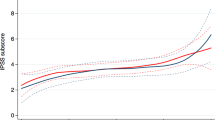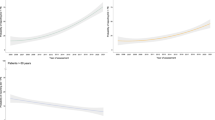Abstract
The aim of the present study was to investigate which PD specific factors (e.g., degree of penile curvature, levels of pain) cause most distress and to further explore whether there are specific subgroups of patients that report particularly high levels of psychological distress. Data were available for N = 119 men with a clinical diagnosis of PD presenting at a private Uro-Andrology in Germany. The strongest complaint of men with PD was being bothered by the look of the penis as opposed to being distressed by the pain (3.48 vs. 2.11). 75.4% reported having significantly less intercourse due to PD and for 61.4% this was very bothersome. Plaque size correlated positively with the level of symptom bother (r = 0.73, p < 0.05). Furthermore, men with a stronger curvature reported more concerns regarding size and form of the penis (r = 0.18, p < 0.05), more overall sexual dissatisfaction (r = −0.38, p < 0.001), and more PD related psychological and physiological symptoms (r = 0.58, p < 0.001). 44.4% of patients had a concurrent ED. Highest level of symptom bother was reported by men with a a strong curvature and a comorbid ED. Clinicians should pay special attention to patients presenting with extreme penile deformity and impaired sexual functioning, as they show the highest levels of psychological distress. Here, additional psychosexual support might be necessary.
This is a preview of subscription content, access via your institution
Access options
Subscribe to this journal
Receive 8 print issues and online access
$259.00 per year
only $32.38 per issue
Buy this article
- Purchase on Springer Link
- Instant access to full article PDF
Prices may be subject to local taxes which are calculated during checkout

Similar content being viewed by others
References
Pryor JP, Ralph DJ. Clinical presentations of Peyronie’s disease. Int J Impot Res. 2002;14:414–7.
Sommer F, Schwarzer U, Wassmer G, Bloch W, Braun M, Klotz T, Engelmann U. Epidemiology of Peyronie’s disease. Int J Impot Res. 2002;14:379–83.
Schwarzer U, Sommer F, Klotz T, Braun M, Reifenrath B, Engelmann U. The prevalence of Peyronie’s disease: results of a large survey. BJU Int. 2001;88:727–30.
Lindsay MB, Schain DM, Grambsch P, Benson RC, Beard CM, Kurland LT. The incidence of Peyronie’s disease in Rochester, Minnesota, 1950 through 1984. J Urol. 1991;146:1007–9.
Bjekic MD, Vlajinac HD, Sipetic SB, Marinkovic JM. Risk factors for Peyronie’s disease: a case-control study. BJU Int. 2006;97:570–4.
Herati AS, Pastuszak AW. The genetic basis of Peyronie’s disease: a review. Sex Med Rev. 2016;4:85–94.
Moreno SA, Morgentaler A. Testosterone deficiency and Peyronie’s disease: pilot data suggesting a significant relationship. J Sex Med. 2009;6:1729–35.
Davila HH, Magee TR, Zuniga FI, Rajfer J, Gonzalez-Cadavid NF. Peyronie’s disease associated with increase in plasminogen activator inhibitor in fibrotic plaque. Urol. 2005;65:645–8.
Mulhall JP. Expanding the paradigm for plaque development in Peyronie’s disease. Int J Impot Res. 2003;5(suppl 5):S93–102.
Iacono F, Prezioso D, Ruffo A, Illiano E, Romis L, Di Lauro G, Romeo G, Amato B. Testosterone deficiency causes penile fibrosis and organic erectile dysfunction in aging men. Evaluating association among Age, TDS and ED. BMC Surg. 2012;12(Suppl 1):S24.
Smith JF, Walsh TJ, Conti SL, Turek P, Lue T. Risk factors for emotional and relationship problems in Peyronie’s disease. J Sex Med. 2008;5:2179–84.
Nelson CJ, Diblasio C, Kendirci M, Hellstrom W, Guhring P, Mulhall JP. The chronology of depression and distress in men with Peyronie’s disease. J Sex Med. 2008;5:1985–90.
Rosen R, Catania J, Lue T, Althof S, Henne J, Hellstrom W, Levine L. Impact of Peyronie’s disease on sexual and psychosocial functioning: Qualitative findings in patients and controls. J Sex Med. 2008;5:1977–84.
Hartzell R. Psychosexual symptoms and treatment of Peyronie’s disease within a collaborative care model. Sex Med. 2014;2:168–77.
Mulhall JP, Schiff J, Guhring P. An analysis of the natural history of Peyronie’s disease. J Urol. 2006;175:2115–8. discussion 2118
Bella AJ, Perelman MA, Brant WO, Lue TF. Peyronie’s disease (CME). J Sex Med. 2007;4:1527–38.
El-Sakka AI. Prevalence of Peyronie’s disease among patients with erectile dysfunction. Eur Urol. 2006;49:564–9.
Hellstrom WJ, Feldman R, Rosen RC, Smith T, Kaufman G, Tursi J. Bother and distress associated with Peyronie’s disease: validation of the Peyronie’s disease questionnaire. J Urol. 2013;190:627–34.
Coyne KS, Currie BM, Thompson CL, Smith TM. Responsiveness of the Peyronie’s Disease Questionnaire (PDQ). J Sex Med. 2015;12:1072–9.
Giraldi A, Rellini A, Pfaus JG, Bitzer J, Laan E, Jannini EA, Fugl-Meyer AR. Questionnaires for assessment of female sexual dysfunction: a review and proposal for a standardized screener. J Sex Med. 2011;8:2681–706.
Hatzichristou D, Rosen RC, Denogatis LR, Low WY, Sadovsky R, Symonds T. Recommendations for the clinical evaluation of men and women with sexual dysfunction. J Sex Med. 2010;7:337–48.
Fugl-Meyer KS, Nilsson M, Hylander B, Lehtihet M. Sexual function and testosterone level in men with conseratively treated chronic kidney disease. Am J Mens Health. 2017;11:1069–76.
Rosen RC, et al. The International Index of Erectile Function (IIEF): a multidimensional scale for assessment of erectile dysfunction. Urol. 1997;49:822–30.
Cappelleri JC, et al. Some developments on the International Index of Erectile Function (IIEF). Drug Info. 1999;33:179–90.
Wiltink J, Hauck EW, Phädayanon M, Weidner W, Beutel ME. Validation of the German version of the International Index of Erectile Function (IIEF) in patientswith erectile dysfunction, Peyronie’s disease and controls. Int J Impot Res. 2003;15:192–7.
Heinemann LAJ, Zimmermann T, Vermeulen A, Thiel C, Hummel W. A new ‘aging males’ symptoms’ rating scale. Aging Male. 1999;2:105–14.
Daig I, Heinemann LA, Kim S, Leungwattanakij S, Badia X, et al. The Aging Males’ Symptoms (AMS) scale: review of its methodological characteristics. Health Qual Life Outcomes. 2003;1:77.
Heinemann L, Saad F, Zimmermann T, Novak A, Myon E, Badia X, Potthoff P, T’Sjoen G, Pöllänen P, Goncharow NP, Kim S, Giroudet C. The Aging Males’ Symptoms (AMS) scale: update and compilation of international versions. Health Qual Life Outcomes. 2003;1:15.
Silberstein LR, Mishkind ME, Striegel-Moore RH, Timko C, Rodin J. Men and their bodies: a comparison of homosexual and heterosexual men. Psychosom Med. 1989;51:337–46.
Veale D, Miles S, Read J, Troglia A, Wylie K, Muir G. Sexual functioning and behavior of men with body dysmorphic disorder concerning penis size compared with men anxious about penis size and with controls: a cohort study. Sex Med. 2015;3:147–55.
Herbenick D, Schick V, Reece M, Sanders SA, Fortenberry JD. The development and validation of the male genital self-image scale: results from a nationally representative probability sample of men in the United States. J Sex Med. 2013;10:1516–25.
Althof SE, Cappelleri JC, Shpilsky A, Stecher V, Diuguid C, Sweeney M, et al. Treatment responsiveness of the Self-Esteem And Relationship questionnaire in erectile dysfunction. Urol. 2003;61:888–92.
Lawrance K-A, Byers ES. Sexual satisfaction in long-term heterosexual relationships: the interpersonal exchange model of sexual satisfaction. Pers Rel. 1995;2:267–85.
Rosen R, Catania J, Lue T, Althof S, Henne J, Hellstrom W, Levine L. Impact of Peyronie’s disease on sexual and psycho- social functioning: qualitative findings in patients and con- trols. J Sex Med. 2008;5:1977–84.
Wylie KR, Eardley I. Penile size and the “small penis syndrome”. BJU Int. 2007;99:1449–55.
Bacal V, Rumohr J, Sturm R, Lipshultz LI, Schumacher M, Grober ED. Correlation of degree of penile curvature between patient estimates and objective measures among men with Peyronie’s disease. J Sex Med. 2009;6:862–5.
El-Sakka AI. Prevalence of Peyronie´s disease among patients with erectile dysfunction. Eur Urol. 2006;49:564–9.
Paulis G, Romano G, Paulis A. Prevalence, psychological impact and risk factors of erectile dysfunction in patients with Peyronie´s disease: a retrospective analysis of 309 cases. Res Rep Urol. 2016;8:95–103.
Serefoglu EC, Smith TM, Kaufman GJ, Liu G, Yafi FA, Hellstrom WJG. Factors associated with erectile dysfunction and the Peyronie’s disease questionnaire in patients with Peyronie disease. Urology. 2017;107:155–60.
Chung E, De YL, Brock GB. Penile duplex ultrasonography in men with Peyronie’s disease: is it veno-occlusive dysfunction or poor cavernosal arterial inflow that contributes to erectile dysfunction? J Sex Med. 2011;8:3446–51.
Cavallini G, Biagiotti G, Lo Giudice C. Association between Peyronie disease and low serum testosterone levels: detection and therapeutic considerations. J Androl. 2012;33:381–8.
Sturm R, Rumohr J, Lipshultz L, Mohamed O, Khera M. Increased incidence of hypogonadism in patients with a novel diagnosis of peyronie’s disease as compared to organic erectile dysfunction. J Urol. 2009;181:278–9.
Shenoy-Bhangle A, Perez-Johnston R, Singh A. Penile imaging. Radiol Clin North Am. 2012;50:1167–81.
Funding
This study received no external funding.
Author information
Authors and Affiliations
Corresponding author
Ethics declarations
Conflict of interest
The authors declare that they have no conflict of interest.
Rights and permissions
About this article
Cite this article
Burri, A., Porst, H. The relationship between penile deformity, age, psychological bother, and erectile dysfunction in a sample of men with Peyronie’s Disease (PD). Int J Impot Res 30, 171–178 (2018). https://doi.org/10.1038/s41443-018-0029-3
Received:
Revised:
Accepted:
Published:
Issue Date:
DOI: https://doi.org/10.1038/s41443-018-0029-3
This article is cited by
-
Safety and feasibility of percutaneous needle tunneling with platelet-rich plasma injections for Peyronie’s disease in the outpatient setting: a pilot study
International Journal of Impotence Research (2024)
-
Is there a new role for oral therapy to treat peyronie’s disease? Commentary on Daily low-dose tadalafil may reduce the penile curvature progression rate in patients with acute Peyronie’s Disease: a retrospective comparative analysis
International Journal of Impotence Research (2024)
-
Comparison of patient-reported outcomes after penile prosthesis placement in men with and without Peyronie’s disease
International Journal of Impotence Research (2023)
-
Validation of the Italian version of the Peyronie’s Disease Questionnaire (PDQ)
International Journal of Impotence Research (2023)
-
Trends in treatment of Peyronie’s disease in adult men in the United States from 2008 to 2017—results from an encounter and claims database
International Journal of Impotence Research (2022)



